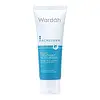What's inside
What's inside
 Key Ingredients
Key Ingredients

 Benefits
Benefits

 Concerns
Concerns

 Ingredients Side-by-side
Ingredients Side-by-side

Water
Skin ConditioningGlycerin
HumectantNiacinamide
SmoothingButylene Glycol
HumectantHydrogenated Polydecene
Emollient1,2-Hexanediol
Skin ConditioningCetearyl Alcohol
EmollientCetearyl Olivate
Cetyl Ethylhexanoate
EmollientSorbitan Olivate
EmulsifyingBeeswax
Emulsion StabilisingVinyldimethicone
Anhydroxylitol
HumectantCitric Acid
BufferingEthylhexylglycerin
Skin ConditioningGlyceryl Stearate
EmollientHyaluronic Acid
HumectantHydrolyzed Cicer Seed Extract
Skin ProtectingHydrolyzed Hyaluronic Acid
HumectantPancratium Maritimum Extract
BleachingPentasodium Pentetate
Propanediol
SolventRhododendron Chrysanthum Leaf Extract
MaskingSodium Hyaluronate
HumectantSodium Polyacryloyldimethyl Taurate
Emulsion StabilisingTocopherol
AntioxidantTricholoma Matsutake Extract
Skin ConditioningTrideceth-10
CleansingXylitol
HumectantXylitylglucoside
HumectantWater, Glycerin, Niacinamide, Butylene Glycol, Hydrogenated Polydecene, 1,2-Hexanediol, Cetearyl Alcohol, Cetearyl Olivate, Cetyl Ethylhexanoate, Sorbitan Olivate, Beeswax, Vinyldimethicone, Anhydroxylitol, Citric Acid, Ethylhexylglycerin, Glyceryl Stearate, Hyaluronic Acid, Hydrolyzed Cicer Seed Extract, Hydrolyzed Hyaluronic Acid, Pancratium Maritimum Extract, Pentasodium Pentetate, Propanediol, Rhododendron Chrysanthum Leaf Extract, Sodium Hyaluronate, Sodium Polyacryloyldimethyl Taurate, Tocopherol, Tricholoma Matsutake Extract, Trideceth-10, Xylitol, Xylitylglucoside
Dimethicone
EmollientButylene Glycol
HumectantGlycerin
HumectantHydroxyethyl Acrylate/Sodium Acryloyldimethyl Taurate Copolymer
Emulsion StabilisingIsononyl Isononanoate
EmollientCetearyl Dimethicone Crosspolymer
Sorbitan Stearate
EmulsifyingPolysorbate 60
EmulsifyingSilica
AbrasiveC14-22 Alcohols
Emulsion StabilisingTriethanolamine
BufferingPropylene Glycol
HumectantSalicylic Acid
MaskingPhenoxyethanol
PreservativeC12-20 Alkyl Glucoside
EmulsifyingChlorphenesin
AntimicrobialDisodium EDTA
Parfum
MaskingCapryloyl Glycine
CleansingAscorbyl Tetraisopalmitate
AntioxidantHexylene Glycol
EmulsifyingSarcosine
Skin ConditioningCentella Asiatica Extract
CleansingCinnamomum Zeylanicum Bark Extract
AntimicrobialPolygonum Cuspidatum Root Extract
AntioxidantScutellaria Baicalensis Root Extract
AstringentGlucose
HumectantCamellia Sinensis Leaf Extract
AntimicrobialGlycyrrhiza Glabra Root Extract
BleachingChamomilla Recutita Flower Extract
MaskingRosmarinus Officinalis Leaf Extract
AntimicrobialDimethicone, Butylene Glycol, Glycerin, Hydroxyethyl Acrylate/Sodium Acryloyldimethyl Taurate Copolymer, Isononyl Isononanoate, Cetearyl Dimethicone Crosspolymer, Sorbitan Stearate, Polysorbate 60, Silica, C14-22 Alcohols, Triethanolamine, Propylene Glycol, Salicylic Acid, Phenoxyethanol, C12-20 Alkyl Glucoside, Chlorphenesin, Disodium EDTA, Parfum, Capryloyl Glycine, Ascorbyl Tetraisopalmitate, Hexylene Glycol, Sarcosine, Centella Asiatica Extract, Cinnamomum Zeylanicum Bark Extract, Polygonum Cuspidatum Root Extract, Scutellaria Baicalensis Root Extract, Glucose, Camellia Sinensis Leaf Extract, Glycyrrhiza Glabra Root Extract, Chamomilla Recutita Flower Extract, Rosmarinus Officinalis Leaf Extract
Ingredients Explained
These ingredients are found in both products.
Ingredients higher up in an ingredient list are typically present in a larger amount.
Butylene Glycol (or BG) is used within cosmetic products for a few different reasons:
Overall, Butylene Glycol is a safe and well-rounded ingredient that works well with other ingredients.
Though this ingredient works well with most skin types, some people with sensitive skin may experience a reaction such as allergic rashes, closed comedones, or itchiness.
Learn more about Butylene GlycolGlycerin is already naturally found in your skin. It helps moisturize and protect your skin.
A study from 2016 found glycerin to be more effective as a humectant than AHAs and hyaluronic acid.
As a humectant, it helps the skin stay hydrated by pulling moisture to your skin. The low molecular weight of glycerin allows it to pull moisture into the deeper layers of your skin.
Hydrated skin improves your skin barrier; Your skin barrier helps protect against irritants and bacteria.
Glycerin has also been found to have antimicrobial and antiviral properties. Due to these properties, glycerin is often used in wound and burn treatments.
In cosmetics, glycerin is usually derived from plants such as soybean or palm. However, it can also be sourced from animals, such as tallow or animal fat.
This ingredient is organic, colorless, odorless, and non-toxic.
Glycerin is the name for this ingredient in American English. British English uses Glycerol/Glycerine.
Learn more about Glycerin